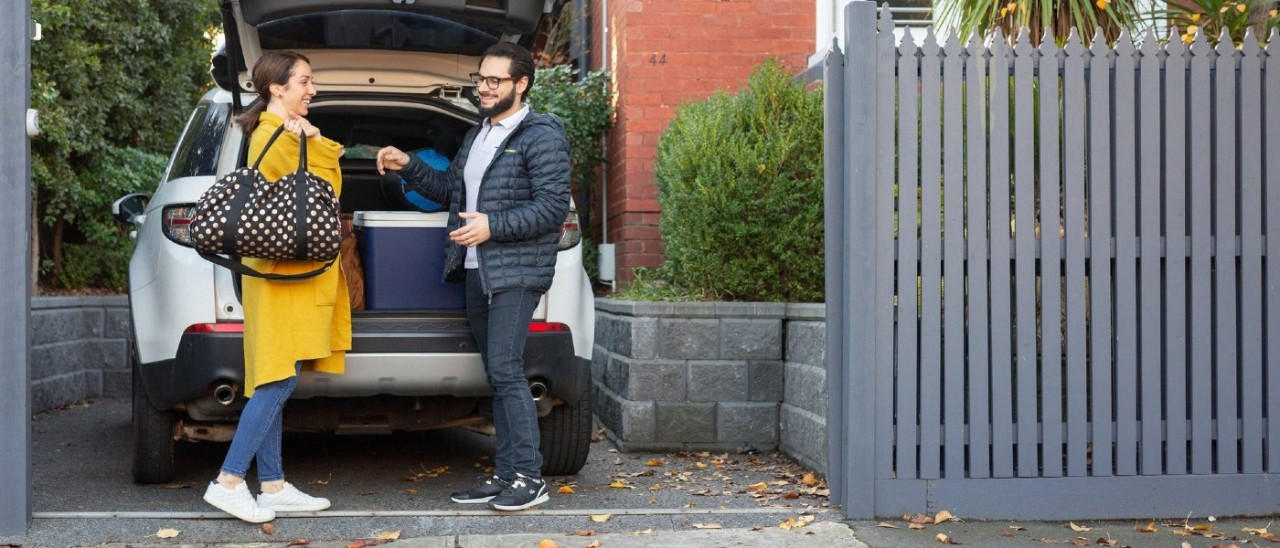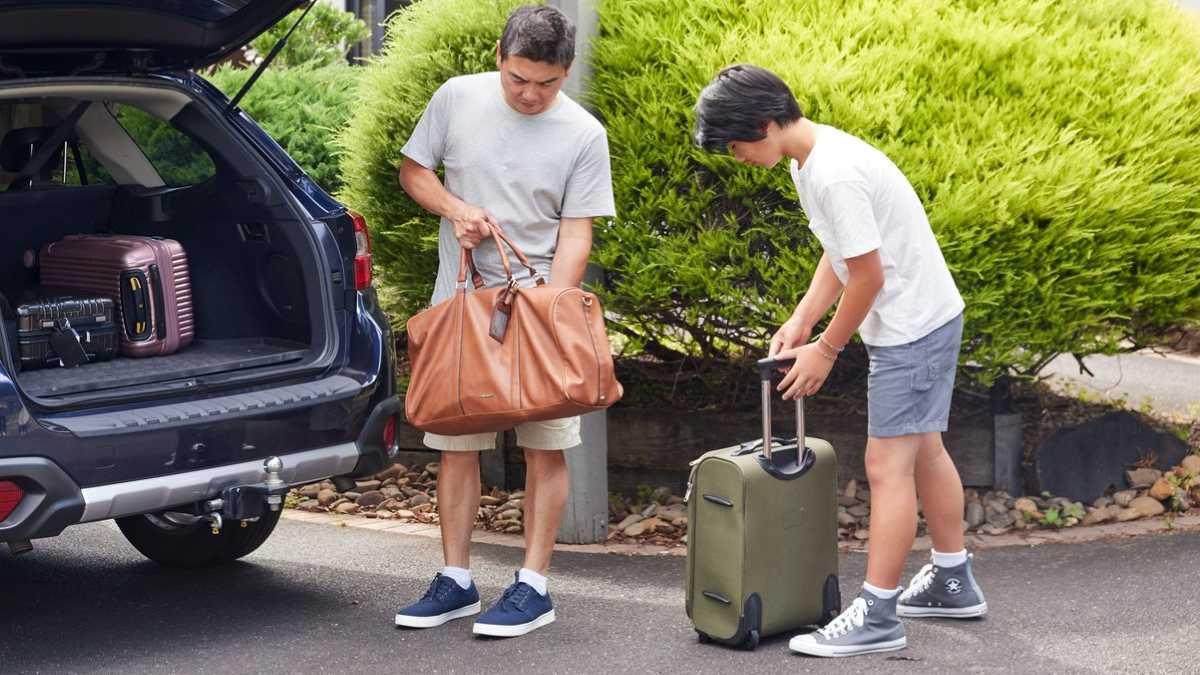Dog doors are convenient but can provide an entry point for thieves. Here’s how you can help prevent theft by securing your dog door.
How to help keep your car and keys safe at home

Car theft is common at residential addresses. Here are some top tips to help keep your car safe from theft in your garage or driveway.
With car theft at record numbers in Victoria, many vehicle owners take precautions when they’re out and about at shopping centres, schools, car parks and other community locations, but they often overlook car safety at home, where it’s just as important to improve the security of your driveway and get the best locks for your garage door.
Data from the Crime Statistics Agency (CSA) shows that 33,018 vehicles were reported stolen in the year ending June 2025, an increase of 42.1 per cent on the previous year. Of the reported vehicle thefts, 12,969 were reported as stolen from a residential location.
“A significant number of car thefts occur in or around private residences,” says Neighbourhood Watch Victoria CEO Bambi Gordon. “That’s why it’s crucial to protect your car when it’s parked at home.”
Tips to help keep your car safe from theft at home
Lock your car
It may seem obvious, but locking your car is one of the most effective ways to prevent theft. Lock your car and take the keys with you whenever you leave your car – even for short stops such as paying for fuel or picking up a food order. Furthermore, lock your car even when you’ve parked it in your garage.
“Don’t forget to lock your back doors and windows,” warns Gordon. “Offenders mainly use these areas to enter cars.”
Store your keys securely
Keeping your keys by the front door might help you remember them, but it can make it easier for car thieves to steal them.
In many cases, thieves now do not even need to steal your physical car keys to gain access to your vehicle. Victoria Police reports that 1 in 5 cars are now being stolen by electronic means, using readily available third-party devices that can copy your key fob signal, gain access to your vehicle and even start the ignition.
Storing your key fob away from front doors and windows, in a Faraday box or bag, or installing an on-board diagnostic (OBD) port lock can help prevent electronic car theft.

Even simple steps like storing your keys out of sight and locking your doors can help prevent car theft.
Remove valuables from your car
In the year to June 2025, CSA recorded 86,351 reports of theft from a motor vehicle - approximately 24,000 more incidents than the year prior.
“Most thieves break into cars because they see something they want inside,” Gordon says. “By removing any valuables from display in your vehicle, you can reduce the likelihood of theft.”
Take phones, laptops, GPS devices, sunglasses, bags, sports equipment, clothes, money (even loose change) and any other portable valuables from your car with you when you leave. Don’t forget to remove phone chargers, power cables from cigarette lighter sockets, GPS holders/cradles and other evidence of technology, too. Remember to remove the suction mark left by any windscreen-mounted cradles. Paperwork should also be removed, as thieves may think they can lift your home address from the files.
“Don’t simply try to hide valuables in your boot or under your seat,” Gordon cautions. “You never know who is watching. If it’s valuable, take it with you.”
Read more: The items you should never leave in the car.

Storing valuables in your car can make you a target for thieves: remove anything of value before leaving your vehicle.
Secure your garage
“Parking off the street in a locked garage or, if you don’t have a garage, a carport or driveway can help deter thieves,” Gordon says. Learn how to improve the security of your driveway or carport for extra protection.
Make sure to keep your garage door closed and locked whenever unattended. Garages are prime targets for Australian burglars, as they often contain easy-to-take valuables such as power tools, golf clubs, and bikes.
To help protect your garage, install the best type of garage door lock for your door type, and learn how to prevent garage break-ins.
Any access doors into your home or garage should also be secured. Deadbolts are widely considered the most effective type of lock, while key safes may increase your risk of being burgled. Consider installing security film on glass panes and accessible windows.
Maintain your home’s exterior to deter thieves
“Homes that look like nobody is home are more likely to be targeted by thieves,” Gordon says. “Regularly maintain your home to keep it looking occupied.”
This can be as simple as mowing your lawn, maintaining your fences, and trimming your shrubs and trees. You can also make use of your home’s blinds, shutters and curtains to prevent window snooping.
“Homes without a security system are three times more likely to be broken into than homes with one,” Gordon warns. A home security system with features such as an alarm, security cameras or smart-home monitoring will warn would-be thieves away from your home. Installing a motion-sensor light or a timed floodlight over your front door, garage and other entry points is also a great burglar deterrent.
Neighbourhood Watch's free quiz, How Safe Is My Place?, helps you review the measures you have in place to protect your home and family and offers tailored tips on how you can increase your security.

Neighbourhood Watch warns that homes without a security system face a greater risk of burglary.
Fit anti-theft devices to your vehicle
A trusted installer can advise you on anti-theft devices and fit one to your vehicle. These devices can include a steering wheel lock, an engine immobiliser, an ignition shield, a battery isolator, or a car alarm.
A growing number of new vehicles also come with in-built Stolen Vehicle Tracking (SVT) capabilities. This feature can help police track and potentially recover your vehicle should it be stolen. Aftermarket SVT devices can also be fitted to your vehicle if it doesn't come with an in-built device.
Number plate theft is also on the rise in Victoria, with 31,980 offences recorded in the year ending June 2025: a 50 per cent increase from the same time period in 2024. Prevent number plate theft by fitting anti-theft screws to your number plates, which are available from most auto shops. You can also attend a Safe Plate event run by Neighbourhood Watch, where you can get anti-theft screws for your number plates.

Fitting anti-theft screws to your number plates can prevent them from being stolen. Image: Getty
Keep records of your vehicle details
In the event of a theft, it helps to have all your vehicle’s relevant details on hand to give to police. Record these vehicle details in a secure place:
- Registration number and state registered
- Vehicle make, model, year, colour, badge, body type, transmission (auto/manual)
- Upholstery colour and other interior details
- VIN (Vehicle Identification Number) – found on your registration certificate or insurance policy document
- Engine number – found on the engine casing
- Fitted accessories: anti-theft devices, radio or speakers, LPG tank, etc.
- Insurance company.
The information provided is general advice only. Before making any decisions please consider your own circumstances and the Product Disclosure Statement and Target Market Determinations. For copies, visit racv.com.au. As distributor, RACV Insurance Services Pty Ltd AFS Licence No. 230039 receives commission for each policy sold or renewed. Product issued by Insurance Manufacturers of Australia Pty Ltd ABN 93 004 208 084 AFS Licence No. 227678.
* The Multi-Policy Discount excludes Travel, Business and Farm Insurance products. To qualify for the Multi-Policy Discount, you must hold two eligible RACV Insurance policies. For further details, see the Premium, Excess and Discounts guide at racv.com.au. Discounts will only be applied until any applicable minimum premium is reached. On renewal, any increases or decreases in your premium may be limited by factors such as your previous year’s premium. You may not save more with more eligible policies and by staying with RACV Insurance longer if a minimum premium is reached, or limits have been applied to increases or decreases in your premium.


